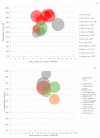The Effectiveness of Different Concepts of Bracing in Adolescent Idiopathic Scoliosis (AIS): A Systematic Review and Meta-Analysis
- PMID: 34063540
- PMCID: PMC8156678
- DOI: 10.3390/jcm10102145
The Effectiveness of Different Concepts of Bracing in Adolescent Idiopathic Scoliosis (AIS): A Systematic Review and Meta-Analysis
Abstract
Brace treatment is the most common noninvasive treatment in adolescent idiopathic scoliosis (AIS); however it is currently not fully known whether there is a difference in effectiveness between brace types/concepts. All studies on brace treatment for AIS were searched for in PubMed and EMBASE up to January 2021. Articles that did not report on maturity of the study population were excluded. Critical appraisal was performed using the Methodological Index for Non-Randomized Studies tool (MINORS). Brace concepts were distinguished in prescribed wearing time and rigidity of the brace: full-time, part-time, and night-time, rigid braces and soft braces. In the meta-analysis, success was defined as ≤5° curve progression during follow-up. Of the 33 selected studies, 11 papers showed high risk of bias. The rigid full-time brace had on average a success rate of 73.2% (95% CI 61-86%), night-time of 78.7% (72-85%), soft braces of 62.4% (55-70%), observation only of 50% (44-56%). There was insufficient evidence on part-time wear for the meta-analysis. The majority of brace studies have significant risk of bias. No significant difference in outcome between the night-time or full-time concepts could be identified. Soft braces have a lower success rate compared to rigid braces. Bracing for scoliosis in Risser 0-2 and 0-3 stage of maturation appeared most effective.
Keywords: adolescent idiopathic scoliosis; brace concepts; brace therapy; meta-analysis; night time brace; rigid brace; systematic review.
Conflict of interest statement
The authors declare no conflict of interest. The funders had no role in the design of the study; in the collection, analyses, or interpretation of data; in the writing of the manuscript, or in the decision to publish the results.
Figures




References
Publication types
Grants and funding
LinkOut - more resources
Full Text Sources

